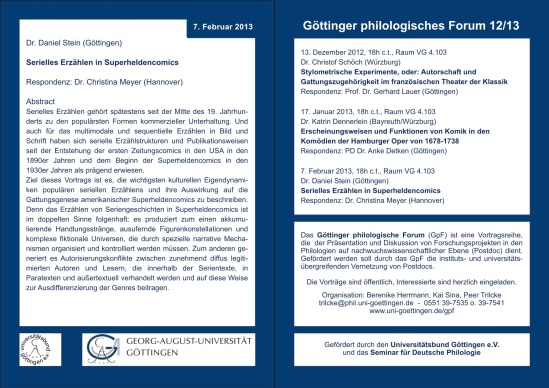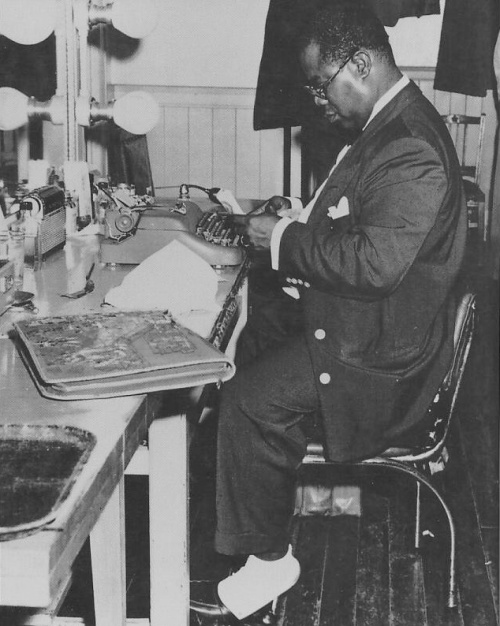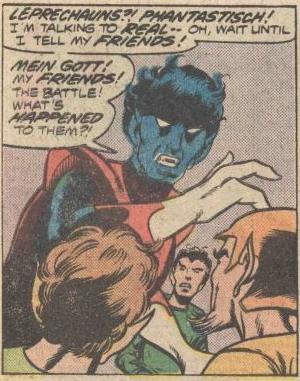
On February 7, 2013, my colleague Daniel Stein will be giving a talk on “Serial Storytelling in Superhero Comics” at the Göttinger philologisches Forum. Click on the flyer above for all the details, contact info, and an abstract.

On February 7, 2013, my colleague Daniel Stein will be giving a talk on “Serial Storytelling in Superhero Comics” at the Göttinger philologisches Forum. Click on the flyer above for all the details, contact info, and an abstract.

American Comic Books and Graphic Novels is a special issue of Amerikastudien / American Studies (issue 56.4), edited by Daniel Stein and Christina Meyer (my co-editors on the forthcoming Transnational Perspectives on Graphic Narratives: Comics at the Crossroads), together with Micha Edlich from the University of Mainz. The special issue, which I just found in my mailbox, has turned out to be a very nice collection of essays, bringing together theorizations of comics and graphic narratives as a medium or medial form and close readings of specific case studies. Also included is an interview with David Mack, conducted by Henry Jenkins. Daniel Stein has posted the full table of contents at his academia.edu page (here).
My own contribution, “Marvel Comics’ Frankenstein: A Case Study in the Media of Serial Figures,” continues my recent explorations of the nexus of seriality and/as mediality. Here’s the abstract:
This essay argues that Marvel’s Frankenstein comics of the 1960s and 1970s offer a useful case study in the dynamics of serial narration, both as it pertains to comics in particular and to the larger plurimedial domain of popular culture in general. Distinguishing between linear and non-linear forms of narrative seriality—each of which correlates with two distinct types of series-inhabiting characters—I argue that Marvel’s staging of the Frankenstein monster mixes the two modes, resulting in a self-reflexive exploration and interrogation of the comics’ story- telling techniques. Furthermore, I contend that this process sheds light on the medial dynamics of serial figures—that is, characters such as the monster (but also superheroes like Batman and Superman or other figures like Tarzan and Sherlock Holmes) that are adapted again and again in a wide variety of forms, contexts, and media. Though narrative continuity may be lacking between the repeated stagings of serial figures, non-diegetic traces of previous incarnations accumulate on such characters, allowing them to move between and reflect upon medial forms, never wholly contained in a given diegetic world. Accordingly, Marvel’s depiction of the Frankenstein monster leads to a self-reflexive probing of comic books’ forms of narrative and visual mediality, ultimately problematizing the very building blocks of comics as a medium—the textual and graphic framings that, together, narrate comics’ serialized stories.

[UPDATE March 28, 2013: The book is now available; see here for more info]
I am pleased to announce that editorial work on Transnational Perspectives on Graphic Narratives: Comics at the Crossroads has been completed, and the manuscript has been turned over to the Bloomsbury production department. The book is now scheduled to appear in March 2013.
The above image is an early mock-up of the cover; I will post the final version, along with any further info, as soon as it becomes available.

Daniel Stein, my indefatigable friend, colleague, and co-editor of Transnational Perspectives on Graphic Narratives (forthcoming from Continuum next year), has just published his monograph Music Is My Life: Louis Armstrong, Autobiography, and American Jazz with the University of Michigan Press. The book is the first extended study of the relation between Louis Armstrong’s writing practices and musical performances and offers a cultural theory of
intermedia and transmedia autobiographics.
On this occasion, Daniel has written a guest blog post on “Armstrong, autobiographics, and a Disney alligator” at the University of Michigan Press blog, which I have been authorized to reproduce here:
The millions of people who went to the movie theaters to watch Disney’s animated film The Princess and the Frog (dir. Ron Clemens and John Musker, 2009) encountered a singing and trumpeting alligator named Louis. Set in a mythologized New Orleans of the 1920s, the movie cooks up a gumbo of popular ingredients ranging from the city’s famous street parades and Mississippi entertainment ships to highly stylized images of Harlem Renaissance dance hall decors. While the anthropomorphic Louis is only one of many side characters, he is especially noteworthy because he pays homage to one of New Orleans’s most famous sons and one of America’s most popular twentieth-century icons: the jazz trumpeter, singer, and actor Louis Armstrong (1901-1971).
For many of Disney’s viewers, connecting the lovable cartoon alligator with the historical Louis Armstrong would have been relatively easy (the trumpet style and speaking voice pretty much give it away). Indeed, ever since Ken Burns’s highly acclaimed PBS documentaryJazz (2001), Armstrong has perhaps been the most visible and readily identifiable figure in American culture. But as I argue in my book, it was not just audiences, journalists, biographers, and documentary filmmakers who contributed to Armstrong’s lasting status as a jazz legend: Armstrong himself actively impacted his public reception and still shapes our understanding of jazz today. How did that happen? Obviously, his recordings from the 1920s (with King Oliver’s Creole Jazz Band as well as his own Hot Five and Hot Seven) until the very end of his life (with the All Stars), his relentless touring all over the world, and his many film roles and television appearances add up to a vast sonic and visual archive of material that fans and scholars continue to mine for meaning.
Yet Armstrong was also a writer, and a prolific one at that. He enjoyed only minimal formal education and did not receive any specific literary training, but he began to write on a daily basis when he moved from New Orleans to Chicago in 1922 and did not stop until he passed away almost fifty years later. He did most of his writing on a portable typewriter but wrote in longhand whenever he did not have access to this typewriter. Over the course of his life, he penned thousands of letters and wrote dozens of longer narratives, including two autobiographical books, Swing That Music (partially ghostwritten and published in 1936) and Satchmo: My Life in New Orleans (1954), and a variety of magazine articles, several of which are collected in Thomas Brothers’s Louis Armstrong, in His Own Words: Selected Writings (1999). The Louis Armstrong House Museum in Queens houses many of these and other materials, and I was privileged to draw on some of their holdings for my research.
My book is the first scholarly attempt to conduct a comprehensive study of Armstrong as a writer. As such, it traces his evolution as a writer over several decades and pays particular attention to his idiosyncratic autobiographical practice: his tendency to treat all written expression as a spontaneous form of life writing in which the moment of autobiographical performance is determined by the writer’s interaction with his medium – typewriter, pen, paper – and his imagined audiences. Once we understand Armstrong along these lines as a vernacular storyteller whose objective was to communicate his views about his life and his music, we get a better sense of how central the autobiographical mode was to all of his expressive efforts, including his singing, trumpet playing, and film acting, as well as his curious habit of assembling photo-collages and preserving snapshots of his public and private lives on his tape recorders.
In the first half of the book, I argue that Armstrong was actually an intermedia performer whose central mode of communication was autobiography and whose autobiographical performances across media were characterized by many of the principles that also structure jazz: spontaneity, interaction, variation, and humor. Dissatisfied with formalistic approaches to Armstrong’s jazz and with biographical studies that too often take the musician’s words and actions at face value, the second half of the book offers extensive historical and cultural contextualization of what I call Satchmo’s autobiographics: the cultural resonances evoked in and through Armstrong’s performances across media. It is especially the controversial history of blackface minstrelsy and its modern reformulations by twentieth-century jazz performers that infuse Armstrong’s productive ambiguities: the manifold, and often contradictory, cultural contexts and racial discourses that were produced by his performances and that trouble all too easy declarations of Armstrong as either a submissive “Uncle Tom” (as many of his detractors had it during the civil rights movement) or an exceptionally cunning trickster figure who transcended racial boundaries and stereotypes (as many of his present-day followers would have it).
Crucially, these ambiguities continue to be productive almost four decades after Armstrong’s death. They can be seen and heard in Disney’s Princess and the Frog as well. After all, alligator Louis is both a masterful jazz musician of the highest order and a clumsy, bumbling comical character whom students of American racial stereotypes will readily associate with the actual and figurative blackface representations that have “colored” American popular culture for at least two centuries. Whether Armstrong would have been the jazz figure of choice for this Disney movie had he not written so prolifically about his life and his music must, of course, remain a matter of speculation. But that Armstrong’s LP Disney Songs the Satchmo Way(1968) has caused both vitriolic criticism as an alleged pandering to minstrel conventions and glorious praise for its supposedly sublime interpretations of popular songs is indeed instructive. I think that rather than siding with one of these assessments, we should dig even deeper into the musician’s textual, sonic, and visual archive and continue to trace the ambiguities that make Satchmo’s autobiographics so endlessly fascinating.

Recently, Daniel Stein (my co-editor, along with Christina Meyer, on Transnational Perspectives on Graphic Narratives: Comics at the Crossroads) wrote an interesting report to which I’d like to draw readers’ attention. Entitled “Comics Studies in Germany: Where It’s At and Where it Might Be Heading,” the article first appeared at Comics Forum. Meanwhile, a German translation has appeared on the website of the Gesellschaft für Comicforschung (here). Whichever language you choose, please do check out Daniel’s article for an insightful look at the current state of a vibrant but still controversial field of research in the German context.

Just a quick reminder that the theme week on “Popular Seriality” is underway over at In Media Res. The first two posts are up, and there’s been some lively discussion. So check it out and spread the word!
Here, again, is the lineup of presenters/curators for the week, along with our titles:
Monday, Dec 12: Frank Kelleter “That Soothing Balm of Latent Discontent: MAD MEN Unstresses the 21st Century” Tuesday, Dec 13: Shane Denson and Ruth Mayer “Plurimediality and the Serial Figure” Wednesday, Dec 14: Jason Mittell
[UPDATE March 28, 2013: The book is now available; see here for more info]
[Update: our publisher, Continuum, now has an official announcement, complete with table of contents: here.]
I am excited to announce Transnational Perspectives on Graphic Narratives: Comics at the Crossroads, an essay collection co-edited by Daniel Stein, Christina Meyer, and myself, which is now officially under contract with Continuum, an international publisher with a strong comics program (you can browse some of their graphic narrative-related titles here). We hope to see the volume appear in 2012; more info will follow before then, but in the meantime here is a short abstract for the collection:
Transnational Approaches to Graphic Narratives: Comics at the Crossroads
Editors: Shane Denson, Christina Meyer, and Daniel Stein
Scholarship on graphic narratives has rarely looked beyond the confines of national borders. While a growing body of studies has turned to different national traditions (Anglo-American comics, Franco-Belgian bande dessinée, Japanese manga, etc.), most critics still treat graphic narratives from different cultures as relatively self-contained phenomena. In fact, scholarship in the emerging field of Comics Studies offers very little analysis of what Shelly Fisher Fishkin has called “the broad array of cultural crossroads shaping the work of border-crossing authors, artists, and cultural forms that straddle multiple regional and national traditions.” (“Crossroads of Cultures: The Transnational Turn in American Studies—Presidential Address to the American Studies Association, November 12, 2004,” American Quarterly 57.1 (2005): 32.)
The overall aim of this collection is to close the gaps in (at least) two major fields of research: 1) in American Studies, broadly defined, where graphic narratives are increasingly accepted as a hybrid, visual-verbal literature that is worthy of critical analysis but where they are frequently placed in an exclusively American context despite the opening of the field towards transcultural and transnational research; and 2) in Comics Studies, which is currently one of the liveliest and most dynamic young fields of critical inquiry but which has, by and large, marginalized the transcultural and transnational dimensions of graphic narratives.
The essays in this collection read graphic narratives as texts that are virtually predisposed towards crossing cultural and national boundaries because their unique visual-verbal interface translates more readily – though not without transformative distortions – across cultures than mono-medial forms of literature, non-narrative artworks, and even film. Our understanding of these texts and their history thus foregrounds the transnational flux of authors and graphic styles as well as the transcultural work that individual works and genres have performed for more than a century. As Paul Williams and James Lyons write: “There are good reasons to understand North American comics in a transnational context: the institutional transaction of texts, creators, and capital across national borders has contributed to observable productive tensions in the comic texts themselves.” (The Rise of the American Comics Artist: Creators and Contexts, Jackson: UP of Mississippi, 2010, xiii.) Following this challenge to consider the transnational exchange of creative energies and their transcultural effects, the first aim which all of the essays in our collection pursue is to engage in the study of American graphic narratives as texts that question and potentially transcend the ideological limitations of national borders.
A second aim of this volume is to situate American graphic narratives in a truly interdisciplinary space in which literary studies, cultural studies, media studies, as well as political and sociological approaches may contribute to redefining the fields of American literature as a truly transnational field of inquiry in which graphic narratives are a major, and increasingly prominent, element. Instead of following uni-directional approaches, all of the essays in this volume follow a notion of multi-directional relationality that has shaped the field of American graphic narratives from its inception (from Japanese woodcuts to early American newspaper comics; from the Eastern European origins of Superman’s inventors to the British authors and artists drawing most contemporary superhero characters) and that has always been at the center of this inherently transcultural and transnational literature.